When something goes wrong with the drive belt on your sled, you know it. You can either feel something is amiss or you can hear it or both.
The snowmobile belt is perhaps one of the most important pieces of equipment on a sled. Without it, you're not going anywhere, unless you're being towed.
A belt can experience any number of different failures that can cause it to lose its ability to get power to the ground.
We asked the tech people at Carlisle (www.carlislesnowbelts.com) to bring our readers up to speed on what those belt issues might be and what you can do to fix it. Carlisle covered just about every belt problem we could think of.
Glazing
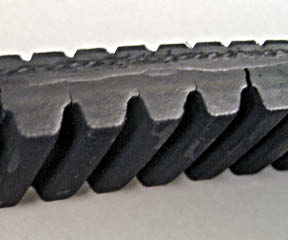 The belt has been overheated, causing it to look melted and shiny in appearance. Glazing is usually caused by belt slippage due to an oil contaminated belt, inadequate belt break-in or improper gear ratio selection for the application.
The belt has been overheated, causing it to look melted and shiny in appearance. Glazing is usually caused by belt slippage due to an oil contaminated belt, inadequate belt break-in or improper gear ratio selection for the application.
Ensure that the drive system is set up properly for the rider and application; consider a lower gear ratio. Make certain that the clutch sheaves and belt are clean and free of contaminants.
Problem: Belt glazed excessively or baked appearance
Possible cause - Excessive slippage caused by insufficient pressure on belt sides
Solution - Check primary clutch for smooth actuation
Possible cause - Slippage caused by excessive horsepower (modified sleds)
Solution - Consult dealer
Possible cause - Excessive slippage from oil or moisture on pulley surfaces
Solution - Check bearing seals and clean pulley
Possible cause - Insufficient pre-load on secondary driven spring
Solution - Repair/replace worn out clutches. Weak or broken springs can cause insufficient pre-load
Possible cause - Excessive operation in low gear
Solution - Inspect converter
Hour Glassing
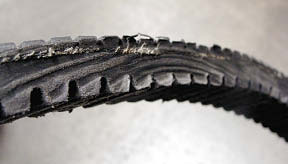 A belt that is worn narrow or uneven in one section is commonly referred to as "hour glassed." Hour glassing is a result of heat that is generated when the drive clutch is spinning and the belt remains stationary. This type of failure can be caused when a belt is too short, belt-to-sheave clearance is incorrect, belt deflection is inadequate, an improper gear ratio is selected or the drive system is locked and/or jammed. Verify that the correct belt and gear ratio are being used; adjust deflection and ensure that belt-to-sheave clearance is correct. See that the drive system moves freely before installing a new belt; repair if needed.
A belt that is worn narrow or uneven in one section is commonly referred to as "hour glassed." Hour glassing is a result of heat that is generated when the drive clutch is spinning and the belt remains stationary. This type of failure can be caused when a belt is too short, belt-to-sheave clearance is incorrect, belt deflection is inadequate, an improper gear ratio is selected or the drive system is locked and/or jammed. Verify that the correct belt and gear ratio are being used; adjust deflection and ensure that belt-to-sheave clearance is correct. See that the drive system moves freely before installing a new belt; repair if needed.
Problem: Belt worn narrow in one section
Possible cause - Secondary seized or not functioning properly
Solution - Repair or replace secondary and replace belt
Possible cause - Excessive idle speed
Solution - Reduce idle speed and replace belt
Possible cause - Excessive slippage in primary caused by locked track
Solution - Rotate track by hand until free. Replace belt.
Disintegration
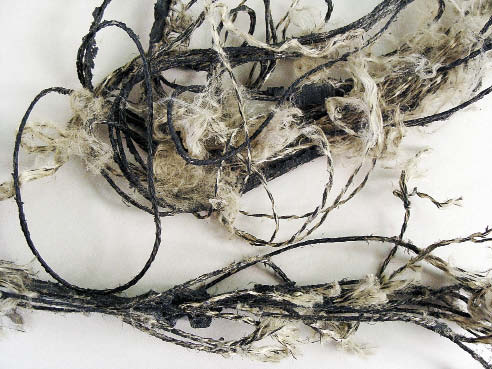 Belt disintegration is the result of major abuse, lack of maintenance and/or a belt used beyond its capabilities. A pre-ride checklist should include checking the drive belt for loose cords, cracks or defects. This type of failure can be caused by different belt conditions such as: hour glassing, glazing, broken cords, flex cracks or misalignment. Verify that the correct belt is being used. Check deflection and belt-to-sheave clearance. Ensure that the proper gear ratio is being used and that the belt and sheaves are clean. Verify integrity and adjustment of motor mounts and torque stop.
Belt disintegration is the result of major abuse, lack of maintenance and/or a belt used beyond its capabilities. A pre-ride checklist should include checking the drive belt for loose cords, cracks or defects. This type of failure can be caused by different belt conditions such as: hour glassing, glazing, broken cords, flex cracks or misalignment. Verify that the correct belt is being used. Check deflection and belt-to-sheave clearance. Ensure that the proper gear ratio is being used and that the belt and sheaves are clean. Verify integrity and adjustment of motor mounts and torque stop.
Problem: Belt disintegration
Possible cause - Excessive belt speed
Solution - Reduce engine rpm at high speed
Possible cause - Clutch misalignment causing belt roll-over
Solution - Align clutches
Possible cause - Excessive slippage/heat built up in belt
Solution - Inspect converter
Possible cause - Excessive operation in low gear
Solution - Inspect converter
Broken Cord
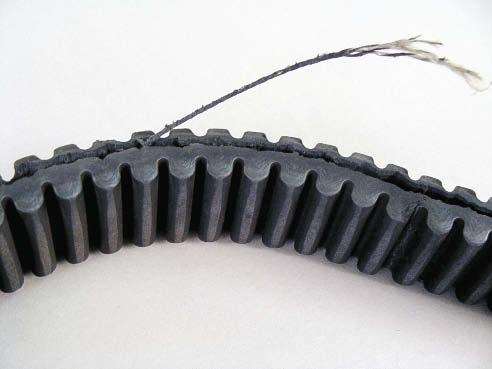 The cords or "tensile members" are the load carrying element of the belt. Cord "pop-out" (cord exiting the sidewall of the belt) is the most common failure mode with snowmobile drive belts. This failure is caused by extreme heat and friction on the side of the belt from clutch misalignment, excessive idle speed or by an improper belt break-in procedure. As the heat melts away the edge of the belt, the cords become exposed and are slowly pulled out by the constant scrubbing of the clutch sheaves. Align clutches to proper offset, reduce idle speed and review proper belt break-in procedure. Do not continue using; further use will cause belt disintegration.
The cords or "tensile members" are the load carrying element of the belt. Cord "pop-out" (cord exiting the sidewall of the belt) is the most common failure mode with snowmobile drive belts. This failure is caused by extreme heat and friction on the side of the belt from clutch misalignment, excessive idle speed or by an improper belt break-in procedure. As the heat melts away the edge of the belt, the cords become exposed and are slowly pulled out by the constant scrubbing of the clutch sheaves. Align clutches to proper offset, reduce idle speed and review proper belt break-in procedure. Do not continue using; further use will cause belt disintegration.
Problem: Belt edge cord broken
Possible cause - Pulley misalignment
Solution - Align pulleys
Possible cause - Improper belt installation
Solution - See owner's manual
Possible cause - Excessive idle speed (belt engaging clutch)
Solution - Reduce idle speed
Possible cause - Excessive pre-load on secondary clutch
Solution - See owner's manual and adjust pre-load
Flex Crack Between Cogs
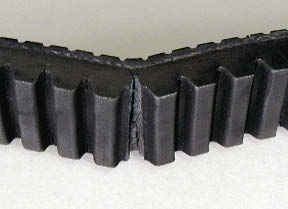 This type of failure can occur if the belt is worn out of its service limit, flexed in extremely cold weather or turned inside out at any time. Do not use drive belts that are out of spec and never turn a drive belt inside out. On a snowmobile, always use the appropriate lift to warm the belt, engine and track. To further improve drive-away during extremely cold temps, warm the belt to room temperature before operating.
This type of failure can occur if the belt is worn out of its service limit, flexed in extremely cold weather or turned inside out at any time. Do not use drive belts that are out of spec and never turn a drive belt inside out. On a snowmobile, always use the appropriate lift to warm the belt, engine and track. To further improve drive-away during extremely cold temps, warm the belt to room temperature before operating.
Problem: Flex crack between cogs
Possible cause - Considerable use, belt worn out
Solution - See Carlisle catalog for replacement belt
Possible cause - Bent pulley flange causing belt distortion
Solution - Repair or replace pulleys
Possible cause - Excessive operation in low gear
Solution - Inspect entire drive system
Possible cause - Operation in extremely low temperature
Solution - Warm up belt before operating
Sheared Cogs
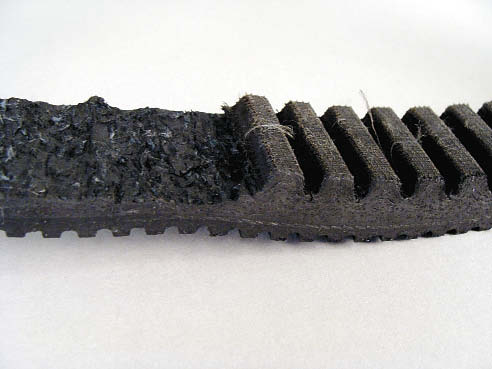 Belts are designed to operate in the same position they are built, right side up. Never turn a belt inside out for inspection (or any reason). This has an adverse effect on the components of the belt and could result in a reduction of drive belt life.
Belts are designed to operate in the same position they are built, right side up. Never turn a belt inside out for inspection (or any reason). This has an adverse effect on the components of the belt and could result in a reduction of drive belt life.
Problem : Sheared cogs
Possible cause - Improper belt installation
Solution - See owner's manual
Possible cause - Belt rubbing stationary object
Solution - Check drive components and remove obstacle
Possible cause - Primary clutch binding
Solution - Inspect primary clutch for damage
Broken Belt
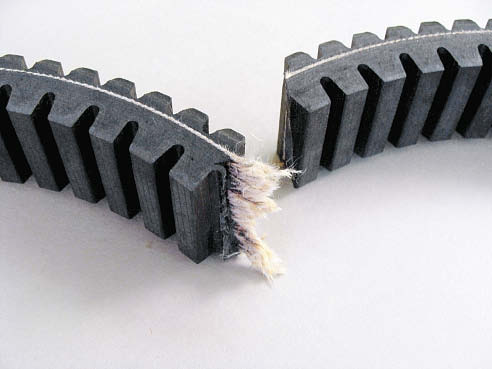 Belt shock loading often causes breakage. Shock loading can be caused by excessively high engagement rpm, a too short belt (binding on the bottom of secondary), improper gear ratio and clutch center-to-center distance being too long or jammed/locked drive train. Driving at top speed or in "overdrive" for extended periods can also cause belt breakage. Verify that the correct belt is being used and the drive train moves freely without resistance. Ensure that engagement rpm is appropriate, clutch center-to-center is correct and gear ratio is not too low. Avoid traveling at top speed for extended periods.
Belt shock loading often causes breakage. Shock loading can be caused by excessively high engagement rpm, a too short belt (binding on the bottom of secondary), improper gear ratio and clutch center-to-center distance being too long or jammed/locked drive train. Driving at top speed or in "overdrive" for extended periods can also cause belt breakage. Verify that the correct belt is being used and the drive train moves freely without resistance. Ensure that engagement rpm is appropriate, clutch center-to-center is correct and gear ratio is not too low. Avoid traveling at top speed for extended periods.
Problem: Broken belt
Possible cause - Engagement speed (rpm) too high
Solution - Reduce engine engagement speed
Possible cause - Belt hanging up on bottom of secondary
Solution - Wrong belt (too short). Replace with correct belt
Possible cause - Locked track
Solution - Rotate track by hand until free